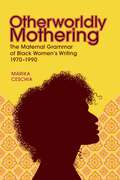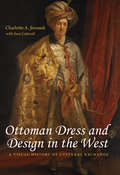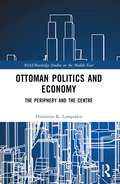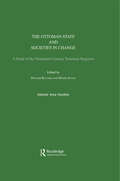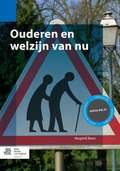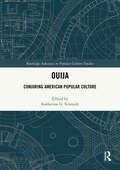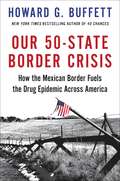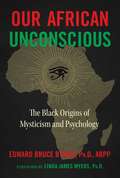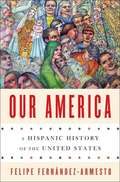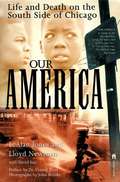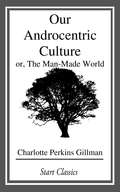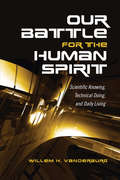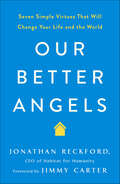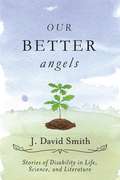- Table View
- List View
Otherworldly Mothering: The Maternal Grammar of Black Women’s Writing, 1970–1990
by Marika CeschiaOtherworldly Mothering argues that literary works by Toni Morrison, Gloria Naylor, Paule Marshall, Audre Lorde, and Toni Cade Bambara reimagine subjectivity in processual and relational terms through a rewriting of maternal praxis, a technique that unveils the historical continuities between antebellum and neoliberal America. By refiguring materials drawn from the tradition of slave narratives, Black women’s literature of the 1970s and 1980s often conjures maternal otherworlds where it is possible to engage alternative modes of being. In conversation with the work of Hortense Spillers, Sylvia Wynter, and Saidiya Hartman, Marika Ceschia analyzes how Black women writers find in the maternal a means of creatively reenvisioning the figure of the human. Morrison’s Song of Solomon, Naylor’s Linden Hills, Marshall’s Praisesong for the Widow, Lorde’s Zami, and Bambara’s The Salt Eaters each change the strictures that dictate how the human is performed. As these texts show, maternal praxis can have a transformative ontological effect: confronting the toll exerted by centuries of racial violence, these writers reclaim the maternal as a site of subject formation.Otherworldly Mothering reassesses canonical works of twentieth-century Black women’s literature alongside theoretical debates around the ontology of the human, antiblackness, and Black motherhood. Ceschia proposes a reappraisal of maternal praxis that challenges neoliberal discourse and questions recent critical turns toward Afropessimism and posthumanism.
Otherworldly Politics: The International Relations of Star Trek, Game of Thrones, and Battlestar Galactica
by Stephen Benedict DysonA compelling look at the analogous political worlds of science fiction, fantasy, and international relations.In Otherworldly Politics, Stephen Benedict Dyson examines the fictional but deeply political realities of three television shows: Star Trek, Game of Thrones, and Battlestar Galactica.Dyson explains how these shows offer alternative histories and future possibilities for humanity. Fascinated by politics and history, science fiction and fantasy screenwriters and showrunners suffuse their scripts with real-world ideas of empire, war, civilization, and culture, lending episodes a compelling intricacy and contemporary resonance.Dyson argues that science fiction and fantasy television creators share a fundamental kinship with great minds in international relations. Screenwriters like Gene Roddenberry, George R. R. Martin, and Ronald D. Moore are world-builders of no lesser creativity, Dyson argues, than theorists such as Woodrow Wilson, Kenneth Waltz, and Alexander Wendt. Each of these thinkers imagines a realm, specifies the rules of its operation, and by so doing shows us something about ourselves and how we interact with one another. Combining intellectual and real-world history with lucid theoretical analysis, the book is a vital challenge to scholars and a spur to creative thinking for fans of these three influential shows.
Otra idea de Cataluña
by Ignasi RieraLa historia de Cataluña para no catalanes. Cataluña es la tierra del seny y de la rauxa, tan abierta a Europa como pegada a sus raíces, tan segura de sí como apocada en ocasiones. Con un profundo conocimiento de su tierra y la inmejorable perspectiva que le ofrece vivir en Madrid, Ignasi Riera nos presenta un recorrido desmitificador e instructivo sobre una nación siempre a vueltas consigo misma y con su encaje en España. Del compromiso de Caspe al oasis catalán, de la fama de hacendosos al rastro literario e histórico de una legendaria pereza y reputación de malhechores, este libro repasa la historia, la literatura, la geografía y hasta la gastronomía para refrescar una mirada sobre Cataluña que parece ya agotada.
Otros nombres del arcoiris: Alegatos contra el machismo
by Braulio PeraltaOtros nombres del arcoíris es un libro necesario para adentrarnos al mosaico de la sexualidad humana. La clandestinidad fue el único espacio para que la minoría lésbico-gay expresara no sólo su erotismo, sino también su forma de ser y vivir. En los setenta surgen los colectivos en defensa de sus derechos humanos. Braulio Peralta ofrece su historia: crónicas de los orígenes de la disidencia gay en México, aquella que con ímpetu buscó un lugar desde el cual existir en igualdad y diversidad junto con el resto de la sociedad. Aquí desfilan personajes valientes y contradictorios, episodios dolorosos como la epidemia del sida, actos de odio -la homofobia-, los prejuicios sin base La denuncia y crítica que Peralta ejerce no va sólo en contra de ciertos sectores segregacionistas o de diversas instituciones represoras, también muestra las incoherencias y peligros del movimiento LGBTTTI. Otros nombres del arcoíris -con fotografías de Maritza López- es un libro necesario para adentrarnos al mosaico de la sexualidad humana.
Otto Binder: The Life and Work of a Comic Book and Science Fiction Visionary
by Richard A. Lupoff Bill SchellyOtto Binder: The Life and Work of a Comic Book and Science Fiction Visionary chronicles the career of Otto Binder, from pulp magazine author to writer of Supergirl, Captain Marvel, and Superman comics. As the originator of the first sentient robot in literature ("I, Robot," published in Amazing Stories in 1939 and predating Isaac Asimov's collection of the same name), Binder's effect on science fiction was profound. Within the world of comic books, he created or co-created much of the Superman universe, including Smallville; Krypto, Superboy's dog; Supergirl; and the villain Braniac. Binder is also credited with writing many of the first "Bizarro" storylines for DC Comics, as well as for being the main writer for the Captain Marvel comics. In later years, Binder expanded from comic books into pure science writing, publishing dozens of books and articles on the subject of satellites and space travel as well as UFOs and extraterrestrial life. Comic book historian Bill Schelly tells the tale of Otto Binder through comic panels, personal letters, and interviews with Binder's own family and friends. Schelly weaves together Binder's professional successes and personal tragedies, including the death of Binder's only daughter and his wife's struggle with mental illness. A touching and human story, Otto Binder: The Life and Work of a Comic Book and Science Fiction Visionary is a biography that is both meticulously researched and beautifully told, keeping alive Binder's spirit of scientific curiosity and whimsy.
Otto Kahn
by Theresa M. CollinsIn the early decades of the twentieth century, almost everyone in modern theater, literature, or film knew of Otto Kahn (1867-1934), and those who read the financial press or followed the news from Wall Street could scarcely have missed his name. A partner at one of America's premier private banks, he played a leading role in reorganizing the U.S. railroad system and supporting the Allied war effort in World War I. The German-Jewish Kahn was also perhaps the most influential patron of the arts the nation has ever seen: he helped finance the Metropolitan Opera, brought the Ballets Russes to America, and bankrolled such promising young talent as poet Hart Crane, the Provincetown Players, and the editors of the Little Review. This book is the full-scale biography Kahn has long deserved. Theresa Collins chronicles Kahn's life and times and reveals his singular place at the intersection of capitalism and modernity. Drawing on research in private correspondence, congressional testimony, and other sources, she paints a fascinating portrait of the figure whose seemingly incongruous identities as benefactor and banker inspired the New York Times to dub him the "Man of Velvet and Steel."
Otto Wood, the Bandit: The Freighthopping Thief, Bootlegger, and Convicted Murderer behind the Appalachian Ballads
by Trevor McKenzieLegions of bluegrass fans know the name Otto Wood (1893–1930) from a ballad made popular by Doc Watson, telling the story of Wood's crimes and violent death. However, few know the history of this Appalachian figure beyond the larger-than-life version heard in song. Trevor McKenzie reconstructs Wood's life, tracing how a Wilkes County juvenile delinquent became a celebrated folk hero. Throughout his short life, Wood was jailed for numerous offenses, stole countless automobiles, lost his left hand, and made eleven escapes from five state penitentiaries, including four from the North Carolina State Prison after a 1923 murder conviction. An early master of controlling his own narrative in the media, Wood appealed to the North Carolina public as a misunderstood, clever antihero. In 1930, after a final jailbreak, police killed Wood in a shootout. The ballad bearing his name first appeared less than a year later.Using reports of Wood's exploits from contemporary newspapers, his self-published autobiography, prison records, and other primary sources, Trevor McKenzie uses this colorful story to offer a new way to understand North Carolina--and arguably the South as a whole—during this era of American history.
Ottoman Dress and Design in the West: A Visual History of Cultural Exchange
by Charlotte Jirousek Sara Catterall&“This amply illustrated, attractive book is valuable for dress history scholars . . . [an] ideal textbook for courses on clothing and cultural history.&” —The Journal of Dress History Ottoman Dress and Design in the West is a richly illustrated exploration of the relationship between West and Near East through the visual culture of dress. Charlotte Jirousek examines the history of dress and fashion in the broader context of western relationships with the Mediterranean world from the dawn of Islam through the end of the twentieth century. The significance of dress is made apparent by the author&’s careful attention to its political, economic, and cultural context. The reader comes to understand that dress reflects not simply the self and one&’s relation to community but also that community&’s relation to a wider world through trade, colonization, religion, and technology. The chapters provide broad historical background on Ottoman influence and European exoticization of that influence, while the captions and illustrations provide detailed studies of illuminations, paintings, and sculptures to show how these influences were absorbed into everyday living. Through the medium of dress, Jirousek details a continually shifting Ottoman frontier that is closely tied to European and American history. In doing so, she explores and celebrates an essential source of influence that for too long has been relegated to the periphery.
Ottoman Notables and Participatory Politics: Tanzimat Reform in Tokat, 1839-1876 (SOAS/Routledge Studies on the Middle East)
by John BraggFocussing on events in the Anatolian town of Tokat during the final two decades of the great Ottoman legal and administrative reforms known as the Tanzimat (1839-76), this book applies elements of social networking theory to analyze and assess the establishment of local governments across the Middle East. The author’s key finding is that the state’s efforts to centralize authority succeeded only when and where locals acted as the primary agents of change. Independent notables, such as the military a‘yân, demanded wealth and state offices in exchange for meting out reform measures according to local idioms of power. Newly created administrative bodies also offered greater social mobility to a growing multiconfessional middle-class in small towns like Tokat. The state was desparate to reform, but opportunistic provincials were eager to have it only on their own terms. Challenging false assumptions about the limited scope of participatory politics in the Middle East during the nineteenth century, Ottoman Notables and Participatory Politics will be of interest to students and scholars of Political Economy, History and Middle East Studies.
Ottoman Politics and Economy: The Periphery and the Centre (SOAS/Routledge Studies on the Middle East)
by Dimitrios K. LamprakisThis book examines the history of the transformation of the small town of Kozani, situated in modern Greek Macedonia, into a vibrant commercial hub and self-administering community during the period of Ottoman rule, c.1400–1821.Beginning with a comprehensive examination of the foundation myths as recorded in local amateur historical works, the book then proceeds with a reconstruction of the foundation of Kozani as a small village during the chaotic Ottoman conquest of Macedonia in the fourteenth and fifteenth centuries. It then examines the history of the village using extant Ottoman and Greek documentation, as well as available Ottoman and European travelogues and geographical treatises. Key moments are highlighted in the socio-economic transformation of the village into a thriving commercial hub and religio-political and administrative centre during the sixteenth, seventeenth and eighteenth centuries. To that end, it discusses the taxation status of Kozani and more particularly the establishment and administration of the mālikāne life-term tax-farming system. The book also examines local myths about communal strife, applying the scheme of bilateral factionalism to explain the repeated waves of intra-communal violence that almost tore the settlement apart.Shedding new light on an area long overlooked by Ottoman historians, the book is vital reading for those interested in the history, politics and economy of Ottoman, Islamic and Balkan towns.
Ouderen en welzijn van nu
by Magteld Beun Theo Royers Hilde De VochtOuderen en welzijn van nu behandelt de levensloopsociologie, met speciale aandacht voor theoretische stromingen rond ouder worden, levensfasen en levensloopindeling, participatie (netwerk, mantelzorg), zelfstandig wonen en mobiliteit (domotica). Verder gaat het boek in op levenslooppsychologie, successfull ageing, de participatiesamenleving, civil society, de WMO, WNS, hierbij passende methodieken en de rol van de professional. Ook is er ruimte voor bijzondere thema´s over ouderenmishandeling, diversiteit, ondersteuning van mantelzorgers en dementerenden. Het boek vormt een geronto-specifieke basis voor allerlei vakken en thema's die in de opleiding aan bod komen. Samen met de website die veel extra materiaal biedt, vormt de uitgave een unieke samenvatting van de oudere van nu. Het boek is geschikt voor het curriculum van de opleidingen social work: MWD, CMV, CT en SPH. In de bachelorfase ouderenzorg, maar ook als uitstroomprofiel in de minorfase en voor opleidingen geriatrie en ouderenzorg. Daarnaast biedt het boek een actuele bijdrage voor de sociaal agogische hulpverleners die momenteel werkzaam zijn in sociale wijkteams en de ouderenzorg.
Ouija: Conjuring American Popular Culture (Routledge Advances in Popular Culture Studies)
by Katherine G. SchmidtTapping into a growing interest in American culture with the occult and new spiritualism, this book is the first scholarly work devoted entirely to the unique place of Ouija in American culture.On the one hand, Ouija has at different moments in history pointed to a deep fascination and openness with the supernatural in the American psyche. On the other hand, Ouija resides squarely outside of orthodox religious belief, and, as we shall see, garners suspicion and even outright rejection from various Christian traditions especially. Thus this cardboard doorway to the supernatural continues to reflect some of the most interesting paradoxes in American life.Bringing together an international team of scholars, this book shows that what qualifies as religious remains an open question, and how Americans continue to grapple with what practices lie within and without the traditions they inherit and pass on.
Our New Jersey (Student Edition)
by Macmillan McGraw-HillMacmillan/McGraw-Hill Grade 4 NEW JERSEY Edition invites students to be a participant in New Jersey’s story from its earliest peoples to the challenges of today. Each unit is developed around the BIG IDEAS of social studies that help students focus and gain a deeper understanding of the New Jersey Academic Content Standards. The New Jersey program builds geographic mastery with map and chart skills, offers reading skills and strategies to reinforce Reading/Language Arts, and integrates Dinah Zike’s Foldables™ to help students improve comprehension. This program also features rich literature selections, primary sources, and Readers’ Theaters that bring New Jersey history alive, citizenship pages that show real-life participation in democracy, and biographies that help students learn about the lives of people who have made a difference throughout New Jersey’s history. The program includes New Jersey Academic Content Standards for each lesson, as well as built-in New Jersey Test Preparation in every unit assessment.
Our 50-State Border Crisis: How the Mexican Border Fuels the Drug Epidemic Across America
by Howard G. Buffett<P>From one of America's most prominent philanthropists, an eye-opening, myth-busting new perspective on the crisis at the U.S.-Mexico border. <P>Howard G. Buffett has seen first-hand the devastating impact of cheap Mexican heroin and other opiate cocktails across America. Fueled by failing border policies and lawlessness in Mexico and Central America, drugs are pouring over the nation's southern border in record quantities, turning Americans into addicts and migrants into drug mules--and killing us in record numbers. Politicians talk about a border crisis and an opioid crisis as separate issues. <P>To Buffett, a landowner on the U.S. border with Mexico and now a sheriff in Illinois, these are intimately connected. Ineffective border policies not only put residents in border states like Texas and Arizona in harm's way, they put American lives in states like Oregon, Pennsylvania, and Vermont at risk. <P>Mexican cartels have grown astonishingly powerful by exploiting both the gaps in our border security strategy and the desperation of migrants--all while profiting enormously off America's growing addiction to drugs. The solution isn't a wall. In this groundbreaking book, Buffett outlines a realistic, effective, and bi-partisan approach to fighting cartels, strengthening our national security, and tackling the roots of the chaos below the border. <P><b>A New York Times Bestseller</b>
Our African Unconscious: The Black Origins of Mysticism and Psychology
by Edward Bruce Bynum• Examines the Oldawan, the Ancient Soul of Africa, and its correlation with what modern psychologists have defined as the collective unconscious • Draws on archaeology, DNA research, history, and depth psychology to reveal how the biological and spiritual roots of religion and science came out of Africa • Explores the reflections of our African unconscious in the present confrontation in the Americas, in the work of the Founding Fathers, and in modern psychospirituality The fossil record confirms that humanity originated in Africa. Yet somehow we have overlooked that Africa is also at the root of all that makes us human--our spirituality, civilization, arts, sciences, philosophy, and our conscious and unconscious minds. In this extensive look at the unfolding of human history and culture, Edward Bruce Bynum reveals how our collective unconscious is African. Drawing on archaeology, DNA research, depth psychology, and the biological and spiritual roots of religion and science, he demonstrates how all modern human beings, regardless of ethnic or racial categorizations, share a common deeper identity, both psychically and genetically--a primordial African unconscious. Exploring the beginning of early religions and mysticism in Africa, the author looks at the Egyptian Nubian role in the rise of civilization, the emergence of Kemetic Egypt, and the Oldawan, the Ancient Soul, and its correlation with what modern psychologists have defined as the collective unconscious. Revealing the spiritual and psychological ramifications of our shared African ancestry, the author examines its reflections in the present confrontation in the Americas, in the work of the Founding Fathers, and in modern Black spirituality, which arose from African diaspora religion and philosophy. By recognizing our shared African unconscious--the matrix that forms the deepest luminous core of human identity--we learn that the differences between one person and another are merely superficial and ultimately there is no real separation between the material and the spiritual.
Our America: A Hispanic History Of The United States
by Felipe Fernández-ArmestoThe United States is still typically conceived of as an offshoot of England, with our history unfolding east to west beginning with the first English settlers in Jamestown. This view overlooks the significance of America's Hispanic past. With the profile of the United States increasingly Hispanic, the importance of recovering the Hispanic dimension to our national story has never been greater. This absorbing narrative begins with the explorers and conquistadores who planted Spain s first colonies in Puerto Rico, Florida, and the Southwest. Missionaries and rancheros carry Spain's expansive impulse into the late eighteenth century, settling California, mapping the American interior to the Rockies, and charting the Pacific coast. During the nineteenth century Anglo-America expands west under the banner of Manifest Destiny and consolidates control through war with Mexico. In the Hispanic resurgence that follows, it is the peoples of Latin America who overspread the continent, from the Hispanic heartland in the West to major cities such as Chicago, Miami, New York, and Boston. The United States clearly has a Hispanic present and future. And here is its Hispanic past, presented with characteristic insight and wit by one of our greatest historians. "
Our America: Life and Death on the South Side of Chicago
by Lealan Jones Lloyd Newman David IsayThrough two award-winning National Public Radio documentaries, and now this powerful book, LeAlan Jones and Lloyd Newman have made it their mission to be loud voices from one of this country's darkest places, Chicago's Ida B. Wells housing project. Set against the stunning photographs of a talented young photographer from the projects,Our America evokes the unforgiving world of these two amazing young men, and their struggle to survive unrelenting tragedy. With a gift for clear-eyed journalism, they tell their own stories and others, including that of the death of Eric Morse, a five-year-old who was dropped to his death from the fourteenth floor of an Ida B. Wells apartment building by two other little boys. Sometimes funny, often painful, but always charged with their dream of Our America,LeAlan Jones and Lloyd Newman reach out to grab your attention and break your heart.
Our American Israel: The Story of an Entangled Alliance
by Amy KaplanHow did a Jewish state come to resonate profoundly with Americans in the twentieth century? Since WWII, Israel’s identity has been entangled with America’s belief in its own exceptionalism. Turning a critical eye on the two nations’ turbulent history together, Amy Kaplan unearths the roots of controversies that may well divide them in the future.
Our Androcentric Culture: or, The Man-Made World
by Charlotte Perkins GillmanA liberal feminist text. Rather than considering what is appropriate masculine or feminine behaviour, we should investigate what it is to be human.
Our Babies, Ourselves: How Biology and Culture Shape the Way We Parent
by Meredith SmallNew parents are faced with innumerable decisions to make regarding the best way to care for their baby, and, naturally, they often turn for guidance to friends and family members who have already raised children. But as scientists are discovering, much of the trusted advice that has been passed down through generations needs to be carefully reexamined.A thought-provoking combination of practical parenting information and scientific analysis, Our Babies, Ourselves is the first book to explore why we raise our children the way we do--and to suggest that we reconsider our culture's traditional views on parenting.In this ground-breaking book, anthropologist Meredith Small reveals her remarkable findings in the new science of ethnopediatrics. Professor Small joins pediatricians, child-development researchers, and anthropologists across the country who are studying to what extent the way we parent our infants is based on biological needs and to what extent it is based on culture--and how sometimes what is culturally dictated may not be what's best for babies.Should an infant be encouraged to sleep alone? Is breast-feeding better than bottle-feeding, or is that just a myth of the nineties? How much time should pass before a mother picks up her crying infant? And how important is it really to a baby's development to talk and sing to him or her?These are but a few of the important questions Small addresses, and the answers not only are surprising but may even change the way we raise our children.From the Trade Paperback edition.
Our Battle for the Human Spirit: Scientific Knowing, Technical Doing, and Daily Living
by Willem H. VanderburgWestern society has become saturated with scientific and technological modes of thinking that impact our lives and our relationships. Expanding social inequality, the use of social media and the rise of mental illnesses such as anxiety and depression are manifestations of this shift in our civilization.Our Battle for the Human Spirit is a comprehensive probe into what is happening to human life in the beginning of the 21st century. It explores how culture, experience, and symbolization have been replaced by scientific, discipline-based, approaches. Willem H. Vanderburg argues that these approaches are inadequate in understanding the complexity of human lives and societies. In order to transcend these limits, Vanderburg calls for the reintegration of culture and symbolization into our daily lives.
Our Better Angels: Seven Simple Virtues That Will Change Your Life and the World
by Jonathan ReckfordInspiring and insightful, Our Better Angels: Seven Simple Virtues That Will Change Your Life and the World celebrates the shared principles that unite and enable us to overcome life’s challenges together.“When the waters rise, so do our better angels.”—President Jimmy CarterJonathan Reckford, the CEO of Habitat for Humanity, has seen time and again the powerful benefits that arise when people from all walks of life work together to help one another. In this uplifting book, he shares true stories of people involved with Habitat as volunteers and future homeowners who embody seven timeless virtues—kindness, community, empowerment, joy, respect, generosity, and service—and shows how we can all practice these to improve the quality of our own lives as well as those around us.A Vietnam veteran finds peace where he was once engaged in war. An impoverished single mother offers her family’s time and energy to enrich their neighbors’ lives. A Zambian family of nine living in a makeshift tent makes room to shelter even more. A teenager grieving for his mother honors her love and memory by ensuring other people have a place to call home. A former president of the United States leads by example with a determined work ethic that motivates everyone around him to be the best version of themselves.These stories, and many others, illustrate how virtues become values, how cooperation becomes connection, and how even the smallest act of compassion can encourage actions that transform the world around us. Here are tales that will make readers laugh and cry and embrace with passion the calling of our better angels to change the way we take care of ourselves, our families, our communities, and the world.
Our Better Angels: Stories of Disability in Life, Science, and Literature
by J David SmithDo children and adults with disabilities enrich our lives? Far more than most people imagine.Our Better Angels is a testament to the value of individuals with disabilities and the value that society could derive from being more welcoming to and inclusive of them. The reward is the powerful humanizing influence that they can have on others-even some of the most hardened people among us.Colorful, real-life examples illustrate how a disability can be a valuable human attribute, a powerful source of compassion from which everyone can benefit.What are the challenges that face us as we strive for a more inclusive society? What are the values that should guide us in our efforts? Smith approaches these questions by examining his own experience and other unique perspectives: Meet the children and adults with disabilities who have touched his own life Consider what science-and pseudoscience-has said about disability View disability through the lens of history and literatureThe result is a compelling case for understanding and celebrating human diversity. Smith asks us to summon the "better angels" of our character and affirm our commitment to a society based on equality and democracy.
